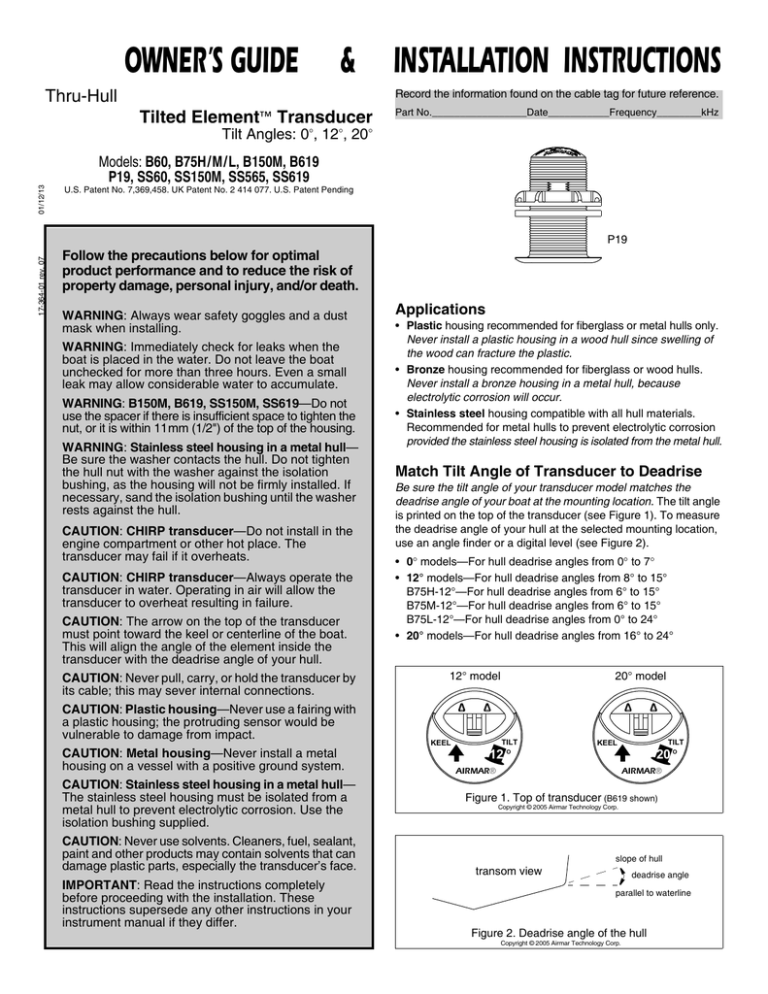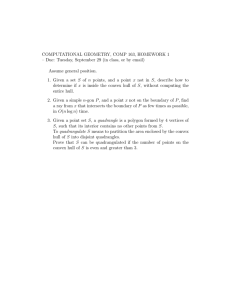
OWNER’S GUIDE
& INSTALLATION INSTRUCTIONS
Thru-Hull
Record the information found on the cable tag for future reference.
Tilted Element™ Transducer
Part No._________________Date___________Frequency________kHz
01/12/13
Tilt Angles: 0°, 12°, 20°
Models: B60, B75H/M/L, B150M, B619
P19, SS60, SS150M, SS565, SS619
U.S. Patent No. 7,369,458. UK Patent No. 2 414 077. U.S. Patent Pending
17-364-01 rev. 07
P19
Follow the precautions below for optimal
product performance and to reduce the risk of
property damage, personal injury, and/or death.
WARNING: Always wear safety goggles and a dust
mask when installing.
WARNING: Immediately check for leaks when the
boat is placed in the water. Do not leave the boat
unchecked for more than three hours. Even a small
leak may allow considerable water to accumulate.
WARNING: B150M, B619, SS150M, SS619—Do not
use the spacer if there is insufficient space to tighten the
nut, or it is within 11mm (1/2") of the top of the housing.
WARNING: Stainless steel housing in a metal hull—
Be sure the washer contacts the hull. Do not tighten
the hull nut with the washer against the isolation
bushing, as the housing will not be firmly installed. If
necessary, sand the isolation bushing until the washer
rests against the hull.
CAUTION: CHIRP transducer—Do not install in the
engine compartment or other hot place. The
transducer may fail if it overheats.
CAUTION: CHIRP transducer—Always operate the
transducer in water. Operating in air will allow the
transducer to overheat resulting in failure.
CAUTION: The arrow on the top of the transducer
must point toward the keel or centerline of the boat.
This will align the angle of the element inside the
transducer with the deadrise angle of your hull.
CAUTION: Never pull, carry, or hold the transducer by
its cable; this may sever internal connections.
CAUTION: Plastic housing—Never use a fairing with
a plastic housing; the protruding sensor would be
vulnerable to damage from impact.
CAUTION: Metal housing—Never install a metal
housing on a vessel with a positive ground system.
CAUTION: Stainless steel housing in a metal hull—
The stainless steel housing must be isolated from a
metal hull to prevent electrolytic corrosion. Use the
isolation bushing supplied.
CAUTION: Never use solvents. Cleaners, fuel, sealant,
paint and other products may contain solvents that can
damage plastic parts, especially the transducer’s face.
IMPORTANT: Read the instructions completely
before proceeding with the installation. These
instructions supersede any other instructions in your
instrument manual if they differ.
Applications
• Plastic housing recommended for fiberglass or metal hulls only.
Never install a plastic housing in a wood hull since swelling of
the wood can fracture the plastic.
• Bronze housing recommended for fiberglass or wood hulls.
Never install a bronze housing in a metal hull, because
electrolytic corrosion will occur.
• Stainless steel housing compatible with all hull materials.
Recommended for metal hulls to prevent electrolytic corrosion
provided the stainless steel housing is isolated from the metal hull.
Match Tilt Angle of Transducer to Deadrise
Be sure the tilt angle of your transducer model matches the
deadrise angle of your boat at the mounting location. The tilt angle
is printed on the top of the transducer (see Figure 1). To measure
the deadrise angle of your hull at the selected mounting location,
use an angle finder or a digital level (see Figure 2).
• 0° models—For hull deadrise angles from 0° to 7°
• 12° models—For hull deadrise angles from 8° to 15°
B75H-12°—For hull deadrise angles from 6° to 15°
B75M-12°—For hull deadrise angles from 6° to 15°
B75L-12°—For hull deadrise angles from 0° to 24°
• 20° models—For hull deadrise angles from 16° to 24°
12° model
20° model
TILT
KEEL
TILT
KEEL
12 O
20 O
AIRMAR®
AIRMAR®
Figure 1. Top of transducer (B619 shown)
Copyright © 2005 Airmar Technology Corp.
slope of hull
transom view
deadrise angle
parallel to waterline
Figure 2. Deadrise angle of the hull
Copyright © 2005 Airmar Technology Corp.
Identify Your Model
Mounting Location
The model name is printed on the cable tag.
Model
(Housing)
Outside Hull
Hole Saw Size
Hull Material
Cored Fiberglass Hull
Hull Interior
Hole Saw Size
CAUTION: Do not mount in line with or near water intake or
discharge openings or behind strakes, fittings, or other hull
irregularities that will disturb the water flow.
P19
fiberglass
metal
51mm or 2"
60mm or 2-3/8"
B150M
B619
SS150M
SS619
CAUTION: Do not mount in line with trailer rollers or bunks that
may damage the transducer’s face.
fiberglass
wood
51mm or 2"
60mm or 2-3/8"
SS150M
SS619
metal
57mm or 2-1/4"
NA
B60
SS60
SS56
fiberglass
wood
60mm or 2-3/8"
80mm or 3-1/8"
B75H/M/L
fiberglass
wood
70mm or 2-3/4"
80mm or 3-1/8"
SS60
SS565
metal
70mm or 2-3/4"
NA
• The water flowing under the hull must be smooth with a
minimum of bubbles and turbulence (especially at high speeds).
• The transducer must be continuously immersed in water.
• The transducer beam must be unobstructed by the keel or
propeller shaft(s).
• Choose a location away from interference caused by power and
radiation sources such as: the propeller(s) and shaft(s), other
machinery, other echosounders, and other cables. The lower
the noise level, the higher the echosounder gain setting that
can be used.
• CHIRP transducer—Mount in a cool well-ventilated area away
from the engine to avoid overheating.
Tools & Materials
Safety goggles
Dust mask
Angle finder
Electric drill with 10mm (3/8") or larger chuck capacity
Drill bit:
3mm or 1/8"
Hole saw (see table above)
Countersink tool (installing SS565)
Sandpaper
Mild household detergent or weak solvent (such as alcohol)
File (installation in a metal hull)
Marine sealant (suitable for below waterline)
Slip-joint pliers (installing a metal housing)
Grommet(s) (some installations)
Cable ties
Water-based anti-fouling paint (mandatory in salt water)
Installation in a cored fiberglass hull (see page 4):
Hole saw for hull interior (see table above)
Fiberglass cloth and resin
or Cylinder, wax, tape, and casting epoxy
Hull Types (see Figure 3)
• Displacement hull powerboats—Locate amidships near the
centerline. The starboard side of the hull where the propeller
blades are moving downward is preferred.
• Planing hull powerboats—Mount well aft, on or near the
centerline, and well inboard of the first set of lifting strakes to
ensure that the transducer will be in contact with the water at high
speeds. The starboard side of the hull where the propeller
blades are moving downward is preferred.
Outboard and I/O—Mount just forward of the engine(s).
Inboard—Mount well ahead of the propeller(s) and shaft(s).
Stepped hull—Mount just ahead of the first step.
Boat capable of speeds above 25kn (29MPH)—Review the
installation location and operating results of similar boats before
proceeding.
• Fin keel sailboats—Mount on or near the centerline and
forward of the fin keel 300–600mm (1–2').
• Full keel sailboats—Locate amidships and away from the keel.
Installation
Hole Drilling
Cored fiberglass hull—Follow separate instructions on page 4.
1. Drill a 3 mm or 1/8" pilot hole from inside the hull. If there is a rib,
strut, or other hull irregularity near the selected mounting
location, drill from the outside.
large displacement hulls
small displacement hulls
planing hulls
outboard and I/O
stepped hull
2. Using the appropriate size outside hull hole saw, cut a hole
from outside of the hull perpendicular to the hull surface (see
table above).
SS565—Use a countersink tool to create a “seat” in the hull.
3. Sand and clean the area around the hole, inside and outside, to
ensure that the sealant will adhere properly to the hull. If there is
any petroleum residue inside the hull, remove it with either mild
household detergent or a weak solvent (alcohol) before sanding.
Metal hull—Remove all burrs with a file and sandpaper.
Bedding
fin keel sailboats
CAUTION; Be sure the surfaces to be bedded are clean and dry.
full keel sailboats
Figure 3.
Best location for transducer
Copyright © 2005 Airmar Technology Corp.
2
Apply a 2mm (1/16") thick layer of marine sealant around the flange
of the housing that contacts the hull and up the sidewall of the
housing (see Figure 4 or 5). The sealant must extend 6mm (1/4")
higher than the combined thickness of the hull, washer(s), hull nut,
and any spacer. This will ensure there is marine sealant in the
threads to seal the hull and to hold the hull nut securely in place.
P19 housing
B60, B75H/M/L, or SS60
B150M, B619, SS150M, or SS619
housing
wrench
flat (2)
wrench
flat (2)
housing
wrench
flat (2)
housing
hull nut
hull nut
hull nut
spacer
washer
washer
washer
hull
hull
hull
marine sealant on flange
and sidewall of housing
marine sealant on flange
and sidewall of housing
marine sealant on flange
and sidewall of housing
Figure 4. Bedding and installing in solid fiberglass or wood hull
Copyright © 2006 Airmar Technology Corp.
Stainless steel housing in a metal hull—To prevent electrolytic
corrosion, the stainless steel housing must be isolated from the
metal hull. Slide the isolation bushing onto the housing (see
Figure 5). Apply additional marine sealant to the surfaces of the
bushing that will contact the hull, filling any cavities in and around
the isolation bushing.
avoid possibly fracturing the housing.
Plastic hull nut—Hand-tighten only. Do not over tighten.
Metal hull nut—Tighten with slip-joint pliers.
Metal hull—Use the spacer if there are not enough threads to
tighten the hull nut against the hull.
Cored Fiberglass Hull—Do not over tighten, crushing the hull.
Wood hull—Allow the wood to swell before tightening the hull nut.
Installing
1. From outside the hull, thread the cable through the mounting
hole. Push the housing into the mounting hole using a twisting
motion to squeeze out excess sealant.
12° and 20° models—From inside the hull, point the arrow on the
top of the transducer (and the cable exit) toward the KEEL or
centerline of the boat (see Figure 1). This will align the angle of the
element inside the transducer with the deadrise angle of your hull.
2. Slide the washer onto the housing (see Figure 4 or 5).
B150M, B619, SS150M, SS619—Also slide the spacer onto the
housing and rest it against the washer. Do not use the spacer if
there is insufficient space to tighten the nut or it is within 11mm
(1/2") of the top of the housing.
Stainless steel housing in a metal hull—Be sure the washer
contacts the hull. Do not tighten the hull nut with the washer
against the isolation bushing, as the housing will not be firmly
installed. If necessary, sand the isolation bushing until the
washer rests against the hull.
3. Screw the hull nut in place.
Plastic housing—Do not clamp tightly on the wrench flats to
SS565
4. Remove any excess marine sealant on the outside of the hull to
ensure smooth water flow under the transducer.
Cable Routing & Connecting
CAUTION: If your transducer came with a connector, do not
remove it to ease cable routing. If the cable must be cut and
spliced, use Airmar’s splash-proof Junction Box No. 33-035 and
follow the instructions provided. Removing the waterproof
connector or cutting the cable, except when using a water-tight
junction box, will void the sensor warranty.
1. Route the cable to the instrument, being careful not to tear the
cable jacket when passing it through the bulkhead(s) and other
parts of the boat. Use grommets to prevent chaffing. To reduce
electrical interference, separate the transducer cable from other
electrical wiring and the engine. Coil any excess cable and
secure it in place using cable ties to prevent damage.
2. Refer to the echosounder owner’s manual to connect the
transducer to the instrument.
SS60, SS150M, or SS619
SS565
solid fiberglass or wood hull
metal hull
metal hull
(SS619 shown)
housing
wrench
flat (2)
wrench
flat (2)
hull nut
washer
hull
marine sealant on flange
and sidewall of housing
wrench
flat (2)
housing
housing
hull nut
hull nut
washer
spacer
hull
hull
isolation
bushing
marine sealant on flange
and sidewall of housing
and isolation bushing where it contacts the hull
washer
isolation
bushing
marine sealant on flange
and side wall of housing
and isolation bushing where it contacts the hull
Figure 5. Bedding and installing
Copyright © 2006 Airmar Technology Corp.
3
Alternatively, a hollow or solid cylinder of the correct diameter
can be coated with wax and taped in place. Fill the gap between
the cylinder and hull with casting epoxy. After the epoxy has set,
remove the cylinder.
9-12 mm
(3/8-1/2")
larger than the
hole through the
hull’s outer skin
pour in
casting
epoxy
inner skin
core
hull thickness
6. Sand and clean the area around the hole, inside and outside, to
ensure that the marine sealant will adhere properly to the hull. If
there is any petroleum residue inside the hull, remove it with
either mild household detergent or a weak solvent (alcohol)
before sanding.
7. Proceed with “Bedding” on page 2.
solid or hollow cylinder
outer skin
Figure 6. Preparing a cored fiberglass hull
Copyright © 2005 Airmar Technology Corp.
Checking for Leaks
When the boat is placed in the water, immediately check around
the transducer for leaks. Note that very small leaks may not be
readily observed. Do not leave the boat in the water for more than
3 hours before checking it again. If there is a small leak, there may
be considerable bilge water accumulation after 24 hours. If a leak
is observed, repeat “Bedding” and “Installing” immediately (see
page 2).
Installation in a Cored Fiberglass Hull
The core (wood or foam) must be cut and sealed carefully. The
core must be protected from water seepage, and the hull must be
reinforced to prevent it from crushing under the hull nut allowing
the housing to become loose.
CAUTION: Completely seal the hull to prevent water seepage into
the core.
1. Drill a 3mm or 1/8" pilot hole from inside the hull (see Figure 6).
If there is a rib, strut, or other hull irregularity near the selected
mounting location, drill from the outside. (If the hole is drilled in
the wrong location, drill a second hole in a better location. Apply
masking tape to the outside of the hull over the incorrect hole
and fill it with epoxy.)
2. Using the appropriate size outside hull hole saw, cut a hole from
outside the hull through the outer skin only (see table on page 1).
3. From inside the hull, using the appropriate size hull interior hole
saw, cut through the inner skin and most of the core. The core
material can be very soft. Apply only light pressure to the hole
saw after cutting through the inner skin to avoid accidentally
cutting the outer skin.
Maintenance & Replacement
Anti-fouling Paint
Surfaces exposed to salt water must be coated with anti-fouling
paint. Use water-based anti-fouling paint only. Never use ketonebased paint, since ketones can attack many plastics possibly
damaging the transducer. Reapply anti-fouling paint every 6
months or at the beginning of each boating season.
Cleaning
Aquatic growth can accumulate rapidly on the transducer’s face,
reducing its performance within weeks. Clean the surface with a
Scotch-Brite® scour pad and mild household detergent, being
careful to avoid making scratches. If the fouling is severe, lightly
wet sand it with fine grade wet/dry paper.
Replacement Transducer & Parts
The information needed to order a replacement transducer is printed
on the cable tag. Do not remove this tag. When ordering, specify the
part number, date, and frequency in kHz. For convenient reference,
record this information on the top of page one.
Lost, broken, and worn parts should be replaced immediately.
Model
Hull Nut
Washer
Isolation
Bushing
Spacer
P19
04-004
09-452
—
—
B60
02-133-01
09-813-01
—
—
B75H/M/L
02-143-01
09-1012-01
—
—
B150M
B619
02-030
09-452
04-646-01
—
SS60
02-563-01
09-813-01
—
04-660-01
SS150M
SS619
02-520-02
09-452
04-646-01
04-186-1
SS565
02-563-01
09-813-01
—
04-589-01
Obtain parts from your instrument manufacturer or marine dealer.
4. Remove the plug of core material, so the inside of the outer skin
and the inner core of the hull is fully exposed. Sand and clean
the inner skin, core, and the outer skin around the hole.
Gemeco
(USA)
5. If you are skilled with fiberglass, saturate a layer of fiberglass
cloth with a suitable resin and lay it inside the hole to seal and
strengthen the core. Add layers until the hole is the correct
diameter.
Airmar EMEA
Tel: +33.(0)2.23.52.06.48
(Europe, Middle East, Africa) Fax: +33.(0)2.23.52.06.49
email: sales@airmar-emea.com
AIRMAR
4
TECHNOLOGY CORPORATION
®
Tel: 803-693-0777
Fax: 803-693-0477
email: sales@gemeco.com
35 Meadowbrook Drive, Milford, New Hampshire 03055-4613, USA
www.airmar.com
Copyright © 2005 - 2013 Airmar Technology Corporation. All rights reserved.





